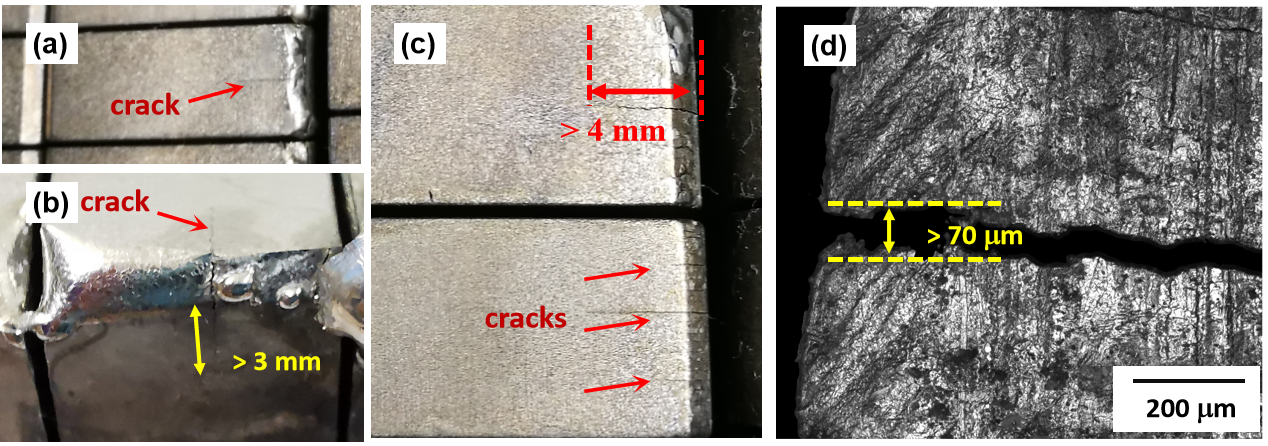Speaker
Description
Leading edge induced material damages are very critical in future fusion devices which may have cassette structure for plasma facing components 1. The upper tungsten divertor in EAST is the first application of active cooled ITER-like W/Cu monoblocks modules in a tokamak 2. The misalignment between neighboring monoblocks was formed inevitably during fabrication and assembly processes, providing the possibility to investigate the leading edge induced damages. The in situ leading edge induced damages, i.e. cracking and melting on W/Cu monoblocks during long pulse operations in EAST were characterized and discussed, which are of important references for ITER and future fusion devices.
Many in-situ tungsten melting phenomenons were observed by means of distinguishing the droplets ejection from CCD video during plasma discharges. Correspondingly, the post mortem inspection also detected the melting vertical length up to 14 cm around strike point on both inner and outer targets [3]. It is found that all tungsten melting occurred only at the edges of cassette modules where larger misalignment up to 3 mm could be formed during assembly process. Due to low misalignment below 0.3 mm between neighoring monoblocks within each cassette module, no any damage was occurred on the edges of monoblocks within cassette module. The melted layer which was mainly driven by the electromagnetic force was moved either up or down in different conditions, and induced only a few bridge connections along polodial direction. Such tungsten melting ejected a large number of droplets into the core plasma, and resulted in a sharp increasing of tungsten impurity and power radiation and could eventually lead to disruptions. With droplets ejection and melted layer removal, the melted corner was leaved with a moderate chamfer structure as depicted in Fig.1. From thermal simulation predictions [3], such beveled structures may mitigate the temperature rise in the following shots. Indeed, no evidence showed that the melted monoblock could be melted again in the following plasma discharges. Such melting does not have a big impact on the EAST operations.

Fig.1. Morphology of a typical leading edge induced melting at G2 cassette module in EAST. (a) the in-situ picture of melting in vacuum vessel; (b) the removed melted monoblocks; (c) the beveled leading edges after melted layer movement and droplets ejection; and (d) the metallic inspection on the near surface.
Meanwhile, many new kinds of macro cracks were also found universally on the edges of cassette modules. They were generally horizontal and along toroidal and radial direction. The cracks were initially generated at the edge corners by leading edge thermal loading, and then propagated into deeper and central areas. Fig. 2 is the typical morphology of cracks generated from leading edges on W/Cu monoblocks. The width of such cracks was about 70 µm, while the depth of cracks can reach up to 4 mm. Since the melting occurs, the temperature can reach up to thousands of oC at leading edges. Accordingly, the thermal stress and strain are in a high level with such high temperature gradient, which could induce such macro cracks. It is noted that such new kinds of cracks were different from the macro cracks along radial direction and poloidal directions during high heat load tests especially under multiple cycles of 20 MW/m2 only on surface of such kinds of W/Cu monoblocks [4]. Such cracks seemed to divide W surface at leading edges equally to similar lamellar structures. Because such cracks were parallel to the heat propagation direction and the elongated grains, they probably have little effect on heat transfer. So far, no clear influence on plasma discharges by such kinds of cracks was found in EAST.

Fig.2. Morphology of cracks at the leading edge of W/Cu monoblocks. (a) the top view of a crack; (b) the side view of a crack; (c) the typical multiple cracks; and (d) the micromorphology of a crack.
Currently, such leading edge induced damages in EAST may be acceptable to some extent. However, with gradually increasing of auxiary heating power, such leading edge induced damages are foreseen to become more seriously, will be likely to restrict the long pulse and high performance operations in future. Thus, further efforts should be performed to mitigate such damages, such as optimization of the chamfering structure to protect the leading edges.
This work was subsidized by the programs of National Natural Science Foundation of China (Nos. 11775260, 11675219, 11675218, 11861131010).
References:
1 Missirlian M, et al., Fusion Eng. Des. 88 (2013) 1793-1797
2 Damao Yao, et al., Fusion Eng. Des. 98-99 (2015) 1692-1695
3 Dahuan Zhu, et al., Nucl. Fusion, 2020, 016036
4 T. Hirai, et al., , Nucl. Mater. Energy. 9 (2016) 616-622.
| Affiliation | Institute of Plasma Physics, Chinese Academy of Sciences |
|---|---|
| Country or International Organization | China |
